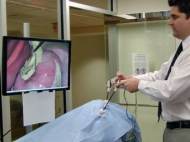Haptic virtual reality tools developed to train and certify surgeons
 Since most of the procedures in modern surgery are performed with remote controlled tools that can be inserted into the body using only small incisions, laparoscopic surgery skips the need for large incisions and, in turn, usually results in shorter recovery times for patients. An interdisciplinary team of researchers, led by Rensselaer Polytechnic Institute, is developing a touch-sensitive virtual reality simulator that will standardize how surgeons are trained and certified to perform laparoscopic procedures.
Since most of the procedures in modern surgery are performed with remote controlled tools that can be inserted into the body using only small incisions, laparoscopic surgery skips the need for large incisions and, in turn, usually results in shorter recovery times for patients. An interdisciplinary team of researchers, led by Rensselaer Polytechnic Institute, is developing a touch-sensitive virtual reality simulator that will standardize how surgeons are trained and certified to perform laparoscopic procedures.
The current system not only places a time burden on the individual being tested and the administrator, it generally requires travel as there are only a few test sites around the USA. The new virtual reality simulator will assess test-takers objectively against board-certified standards and criteria, possibly over the Internet. The new system is also expected to be more cost effective, with a lower price point that should lead to a wider availability across the USA.
Rensselaer’s Professor Suvranu De, Harvard Medical School Professor Daniel B. Jones and human factors engineering expert Caroline G. L. Cao, associate professor of mechanical engineering at Tufts University, are developing new hardware and software that effectively trains surgeons to perform the laparoscopic surgery fundamental tasks, as well as objectively assesses the performance of physicians who are seeking to become certified in laparoscopic surgery. This new testing and training system will employ haptic technology (touch feedback) which realistically replicates the sensation a surgeon would feel in his or her hands during an actual procedure.
“We want to give surgeons the best tools possible, so they can better hone their skills and successfully treat their patients,” said project leader De, associate professor in the Department of Mechanical, Aerospace, and Nuclear Engineering at Rensselaer. “Just as training on virtual reality simulators has shown to be highly effective for jet pilots, we know that physicians show increased success in surgery the more times they perform it. We’re creating new tools that make it easier than ever for them to practice. These same tools will also be used in certification tests to make sure surgeons have all the required skills mastered before they start operating on patients.”
The new system features real laparoscopic tools, which are connected to equipment nearly identical to that used in actual surgical situations. Realistic computer-generated models of the simulation scene are displayed on a monitor, and the users interact with simulation both visually and using their sense of touch. The haptics technology ensures that a physician cutting or stitching tissue with the simulator will feel with their hands the lifelike toughness, sponginess, and resistance of virtual tissue. By pairing haptics with automation, the simulator will also be able to literally guide the hands of trainees, so they can see and feel the correct movements as they learn specific surgical tasks. The research team plans to make these simulations available over the Internet.
After developing the new system, the research team will work to test and validate the effectiveness and usefulness of the system as a testing and training tool at the Carl J. Shapiro Simulation and Skills Center at Beth Israel Deaconess Medical Center in Boston.









Leave your response!